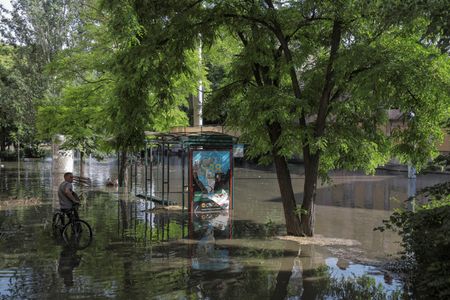By Matthias Williams, Mark Trevelyan and Gloria Dickie
LONDON (Reuters) – The breach of a huge dam on the front-line Dnipro river has muddied the picture for a much-awaited Ukrainian counteroffensive against Russian invaders and threatens an environmental disaster for civilians living in the war zone.
Kyiv and Moscow have blamed each other for the collapse of the Nova Kakhovka dam in southern Ukraine that sent floods gushing towards surrounding towns and farmland and forced hundreds of civilians to flee on Tuesday.
With water levels still rising, officials and analysts have begun to count the human and environmental costs for one of the world’s most fertile agricultural countries, saying settlements, thousands of people and some rare wildlife species are at risk.
At least 150 tonnes of oil from the dam have leaked into the Dnipro, Ukrainian Environment Minister Ruslan Strilets told a press briefing, and the environmental damage had been estimated at 50 million euros ($53.8 million).
The dam’s collapse occurred just as Ukraine was poised to launch a counteroffensive and could complicate the advance of its forces in any assault, analysts said, though Kyiv has not divulged in which direction it plans to strike.
“Bearing in mind Russia is on the strategic defensive and Ukraine on the strategic offensive, in the short term it’s an advantage to Russia, definitely,” said Ben Barry, senior fellow at the International Institute for Strategic Studies.
“It’ll help the Russians until the water subsides because it makes it more difficult for Ukraine to do assault river crossings,” he said in a phone interview.
The floodtide inundating the region will prevent the use of heavy weaponry such as tanks for at least a month, said Maciej Matysiak, security expert at the Stratpoints Foundation and ex-deputy chief of Polish military counter-intelligence.
“(This) creates a very good defending position for Russians who expect Ukrainian offensive activity,” Matysiak said.
The flooding has already submerged villages and towns around the city of Kherson, while Russian officials warn that the main canal supplying water to the Russian-annexed Crimea peninsula is receiving drastically less water.
The dam’s vast reservoir also supplies the cooling waters for Europe’s largest nuclear power plant in Russian-controlled Zaporizhzhia. However, the U.N. nuclear watchdog has played down the immediate risk, saying alternative sources of water could supply the facility for months if necessary.
YEARS OF DAMAGE
But the wider damage to the environment and agriculture in one of the world’s biggest grain exporters could be stark, further stressing global supply chains after the blockade of Ukrainian seaports last year.
Wheat prices surged more than 3% on Tuesday.
“The impact of the flooding we will feel not only for just weeks or even months, but a long period of time,” Strilets said.
“The challenge is it’s a very large dam actually, one of the largest reservoirs in the world,” said Mohammad Heidarzadeh, a civil engineer at the University of Bath in Britain.
“…Based on experience of similar incidents worldwide, a very large area would be impacted and hazardous material spread all over the area that would impact the productivity of the agriculture.”
Heidarzadeh said the mud left behind by the floodwaters would probably take years to clear.
Modupe Jimoh, a professor of Civil and Humanitarian Engineering at the University of Warwick, predicted the dam burst would wash industrial chemicals and lubricants into the soil and water table, damaging ecoystems and biodiversity.
Strilets said downstream wildlife species found nowhere else in the world were in jeopardy, including the sandy blind mole-rat. Ukraine’s Black Sea Biosphere Reserve and two national parks were also likely to be heavily damaged, he added.
Ukrainian Foreign Minister Dmytro Kuleba accused Russia of “ecocide”, saying the flooding would bring irreversible harm. Animals in the Nova Kakhovka Zoo, including monkeys and porcupines, had died in the rising waters, he said.
Russia has denied responsibility and accused Ukraine of sabotaging the dam to deflect from what Moscow said were Ukrainian military failures. Neither side has provided evidence so far for their claims.
Marina Miron, a researcher at King’s College in London, called it a “turning point” in the war but said both sides could see some advantage in blowing up the dam.
“For Russians the reason to do it would have been to stop the Ukrainian counteroffensive, obviously. And to create a humanitarian situation in Kherson, where people need to be evacuated and to create swamps so that Ukrainians would not be able to use their mechanized infantry, for instance,” she said.
For Ukraine, the breach might have provided a way of distracting the Russians while Kyiv launches its counteroffensive, she added.
Patricia Lewis, Research Director for International Security at the Chatham House think tank, said the situation helps Russia even if the Ukrainian counteroffensive later makes inroads.
“For Russia, you can see the immediate benefit in that you’re stopping that connection for Ukrainian forces to get across,” she said in an interview.
“And also…, if they’re not planning on staying there for the long term, for whatever reason, if they think, for example, that they’re not going to win this battle, then they would leave Ukraine with this long-term headache.”
($1 = 0.9351 euros)
(Additional reporting by Aiden Nulty and Ben Tavener; editing by Mark Heinrich)










